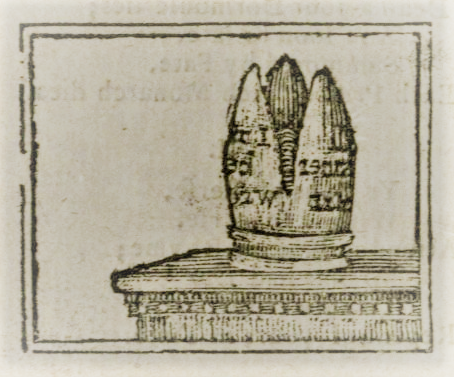The term thinking cap denotes an imaginary cap humorously said to be worn in order to facilitate thinking.
The earliest instance that I have found is from the Western Carolinian (Salisbury, North Carolina) of 16th October 1821:
We advise the editor to put his thinking-cap on, before he hazards another such assertion.
The term also appeared in To Peter Pensive, published in The Enniskillen Chronicle, and Erne Packet (Fermanagh, Ireland) of 18th November 1824:
I tell thee, my friend, I am as jealous of the morals and manners of the young as thou, but they can only be led by subjects which take their fancies. Every thing must have a beginning—fools should not judge of have done work—children must creep before they can walk—a word to the wise is sufficient; —and if thou art not wise enough to take a hint from these proverbs, thou mayest put on thy thinking cap again to guess at my intentions.
The earlier term was considering cap. Its first known user was the English actor and comic writer Robert Armin (1563-1615) in Foole vpon foole, or, Sixe sortes of Sottes (1605). In the story titled How this very foole Iohn of the Hospital, sold a gentlemans paire of boots for a groat, that cost the Cobler fiue shillings, a cobbler mends a gentleman’s boots and sends John to deliver them; but on his way, John sells the boots for a groat, which the cobbler is unaware of:
By & by comes the gentleman in his white linnen boot-hose ready to the purpose. A poxe of lazy Coblers, saies hee, my boots; shall I forfet a bond for your pleasure? The Cobler puts off his considering cap, why sir, sayes he, I sent them home but now.
In The History of Little Goody Two-Shoes; Otherwise called, Mrs. Margery Two-Shoes, an anonymous children’s story published by John Newbery in 1765, a chapter is titled The whole History of the Considering Cap, set forth at large for the Benefit of all whom it may concern:
(1766 edition)
The great Reputation Mrs. Margery acquired by composing Differences in Families, and especially, between Man and Wife, induced her to cultivate that Part of her System of Morality and Economy, in order to render it more extensively useful. For this Purpose, she contrived what she called a Charm for the Passions; which was a considering Cap, almost as large as a Grenadier’s, but of three equal Sides; on the first of which was written, I MAY BE WRONG; on the second, IT IS FIFTY TO ONE BUT YOU ARE; and on the third, I’LL CONSIDER OF IT. The other Parts on the out-side, were filled with odd Characters, as unintelligible as the Writings of the old Egyptians; but within Side there was a Direction for its Use, of the utmost Consequence; for it strictly enjoined the Possessor to put on the Cap, whenever he found his Passions begin to grow turbulent, and not to deliver a Word whilst it was on, but with great Coolness and Moderation. As this Cap was an universal Cure for Wrong-headedness, and prevented numberless Disputes and Quarrels, it greatly hurt the Trade of the poor Lawyers, but was of the utmost Service to the rest of the Community. They were bought by Husbands and Wives, who had themselves frequent Occasion for them, and sometimes lent them to their Children: They were also purchased in large Quantities by Masters and Servants; by young Folks, who were intent on Matrimony, by Judges, Jurymen, and even Physicians and Divines; nay, if we may believe History, the Legislators of the Land did not disdain the Use of them; and we are told, that when any important Debate arose, Cap, was the Word, and each House looked like a grand Synod of Egyptian Priests. Nor was this Cap of less Use to Partners in Trade, for with these, as well as with Husband and Wife, if one was out of Humour, the other threw him the Cap, and he was obliged to put it on, and keep it till all was quiet. I myself saw thirteen Caps worn at a Time in one Family, which could not have subsisted an Hour without them; and I was particularly pleased at Sir Humphry Huffum’s, to hear a little Girl, when her Father was out of Humour, ask her Mamma, if she should reach down the Cap? These Caps, indeed, were of such Utility, that People of Sense never went without them; and it was common in the Country, when a Booby made his Appearance, and talked Nonsense, to say, he had no Cap in his Pocket.

the considering Cap
original illustration for The History of Little Goody Two-Shoes
FOLK ETYMOLOGY
It is often said that thinking cap is an allusion to the official cap donned by a judge when the time came to deliver judgment or pass sentence.
But the contexts of the early uses of considering cap and thinking cap are not judicial. These terms are purely metaphorical. As B. A. Phythian explains in A Concise Dictionary of Phrase and Fable (1993), in the days when everyone wore headgear, caps denoted a wide range of professions, trades and status. It would have been natural for someone who was asked to think about something to be jocularly invited to ‘put on their thinking cap’.
Additionally, in the earlier normal term, considering cap, the alliteration suggests a popular metaphor, not a specific reference to a professional thinker such as a judge.
